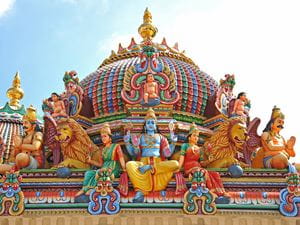
Hindu temples dot the landscape of India, with some of the oldest intact sanctuaries—particularly in the southern regions of the sub-continent—dating back to as early as the 17th and 18th centuries of the Common Era. Of course, the use of temples predates that period by many, many centuries—and there are what appear to be the remains of ancient Hindu temples which date back to the 3rd century BCE. While we don’t know for certain exactly when temples became a significant part of the Hindu life-cycle and worship, we know that the Vedas—the oldest and most sacred of Hindu texts—never make reference to them. However, Hindu temple architectural guides date back to nearly as early as the 4th century of the Common Era, which suggest that these sacred edifices have been part of the Hindu system of worship for a minimum of 1,600 years, and almost certainly longer than that.
Worshiping God in the Temple
In India, temples are often called mandir (Sanskrit for “dwelling place”), because they are perceived as the dwelling place for deities.
Connecting With God Via a Temple
In places like the United States, Hinduism can look a bit different than it does in India. However, as a general rule, there is no “sabbath” in Hinduism, and no weekly congregational worship services wherein practitioners gather (as they would in Christianity, Sikhism, or Islam). Thus, Hindu temples are less places to meet and fellowship with other Hindus and, instead, places to visit to engage in acts of puja (or worship)—through making offerings to one’s god, listening to a priest chant the Vedas, engaging in meditation or prayer, and receiving prasad. In many ways, Hindu temples function as a sort of umbilicus—connecting the human to the divine, through the symbols, the Vedas, the offerings, and the ritual acts that take place therein and the images which serve as the focus or recipient of such acts. Hindus commonly have home shrines in which they can worship their god (or gods) in ways that are just as valid as doing these same acts of devotion in a local temple. However, many feel that they connect on a different or higher level by occasionally or regularly attending a public temple, wherein Brahmin priests perform certain duties and activities which a lay Hindu would not be able to perform for themselves at home.
Being Born Again Through the Temple
Hindu temples are typically laid out in a grid pattern, known as a paramaśāyika or paramaśāyika. At the center is usually what is known as the garbhagriha (or “womb-house”)—which is the inner sanctum of the temple. It is the location wherein the god or murti dwells (or is enshrined). While Hindu temples in the north of India will customarily allow worshippers to make their way to (or into) the garbhagriha, in the south, only the Brahmin priests are allowed to cross over the threshold into the actual womb-house. Regardless of what part of India one dwells in, the sanctifying part of approaching the garbhagriha is to be found in hearing the priest chant the Vedas or capturing a glimpse of the deity housed therein—particularly if one can make “eye contact” with the statue. In doing so, some Hindus believe being spiritually “born again” (to borrow a Christian phrase) is possible. Indeed, the reason it is called a “womb-house” is because practitioners go there to experience a potential spiritual “rebirth” or revitalization—wherein one inches closer and closer to enlightenment and freedom from the rounds of rebirth (or reincarnation).
Temples as Central to Celebrations
In addition to being places of worship and spiritual rebirth, Hindu temples are also central to many of the annual festivals and celebrations—both those which are celebrated only locally but also those which are international Hindu commemorations. Thus, it has been said that “all major festival celebrations include visiting a temple.” The purpose of these “festivals” and “commemorations” have been described as follows:
“Hindu festivals are combinations of religious ceremonies, semi-ritual spectacles, worship, prayer, lustrations, processions, music and dances, eating, drinking, …feeding the poor, and other activities of a religious or traditional character. The original purpose of these activities was to purify, avert malicious influences, renew society, bridge over critical moments, and stimulate or resuscitate the vital powers of nature… Because Hindu festivals relate to the cyclical life of nature, they are supposed to prevent it from stagnating.”
While Indian festivals can have some seemingly secular aspects, much of what they are designed to celebrate, emphasize, and accomplish is tied-up in the primary religious functions of temples as well. Thus, in the life of Hindu communities, separating the festivals from the temples, and the temples from puja and daily life, is an impossible task. All these things are really deeply intertwined.
In his book, Religion Matters (p.6), Harvard University trained professor of religion, Stephen Prothero, notes: “When Hindus go to a temple, they go to look in[to] those eyes [of their deity] to see the god of their choosing look back at them. The Indologist Dana Eck has identified this intimate encounter—darshan, or ‘sacred seeing’—as the heart and soul of bhakti worship” or “devotion” to one’s god. And so it is that Hindus go to temples to worship, to make offerings, to hear the Vedas, to receive and partake of prasad, etc.—but perhaps most of all, to connect with their god, to look into His or Her eyes, and to ensure that that favored deity is aware of the practitioner, is watching over him or her, and that their hopes, needs, and wishes will be heard and met—because of their sincere bhakti (or devotion), as expressed through the yearning in their eyes as they make contact with their god.
2/24/2022 5:55:48 PM










